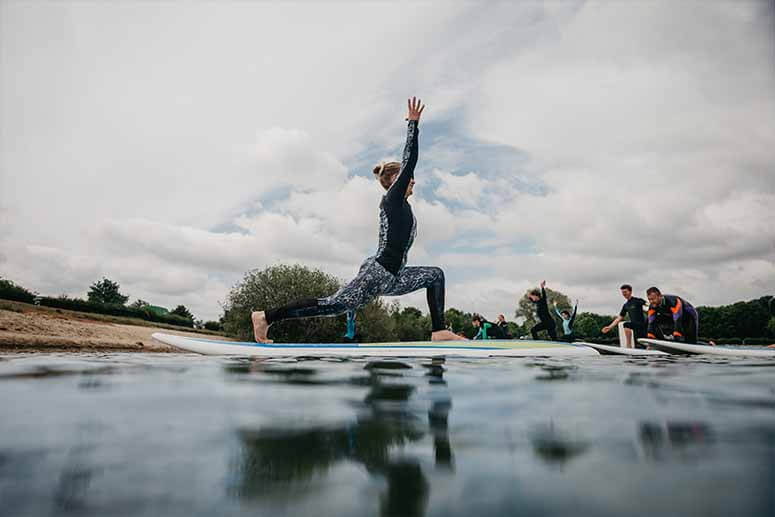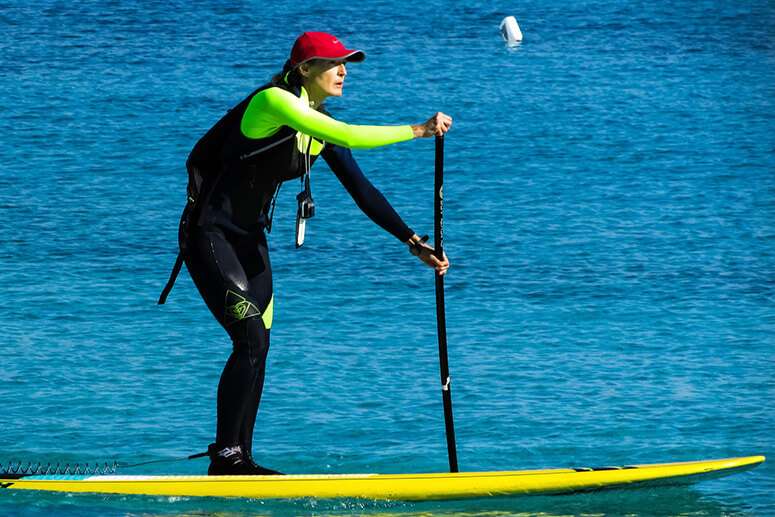
How to Choose a Stand Up Paddle Board – Your Ultimate Buying Guide
Looking for a new, exhilarating activity to do at the beach, while at the same time burn up some calories? Consider one of the hottest watersports everyone is raving about, stand-up paddleboarding or SUP!
Stand-up paddling may seem like a new sport, but it has been around for quite some time. In fact, SUP is considered much older than surfing, tracing back to Africa and South America thousands of years ago.
Now that you are enticed by the excitement and adrenaline brought by SUP, you will need to get your equipment ready. Of course, like most sports and recreational activities, you need proper gear in order to enjoy paddling down the waves.
Having the right board is key for optimum enjoyment. In this buying guide, we’ll review the main points you need to consider when choosing a stand-up paddleboard. Here are the following key points you have to consider when buying a SUP board.
- Types of Paddleboards
- Inflatable Board vs Solid Board
- Hull Types
- Board Width and Length
- Fin Set-ups
To find the ideal stand up paddle board for you, you have to determine what will fit with your body, and how you want it to handle in the water. Other things you have to choose will be the shape of the board, getting the correct volume and capacity, as well as the proper length, width, and thickness.
Types of Paddleboards
With a variety of selections to choose from, buying for the first time may be overwhelming. Remember that each SUP board has its own distinct shape and intended purpose. Select a shape that will match the type of paddleboarding you’d like to do or which body of water you’ll be using it.
Here are the primary types of SUP board to choose from.
The most common and most recommended among beginners are all-around boards. As the name suggests, it can be used in almost any condition thanks to its focus on stability and maneuverability.
Having a larger width compared to other types of paddle board, they are perfect for paddling together with a friend, a loved one, or even a canine friend!
Basically, a touring board is an upgraded version of an all-around board, which makes it the right choice for intermediate and pro paddlers. Its main purpose is long-distance paddling on flatwater.
If you like to glide along with the wind in bays, lakes, and calm ocean, then a touring board is a great option for you. Their displacement hull allows them to efficiently glide on the water and carry more speed over long distances.
Basically, a touring board is an upgraded version of an all-around board, which makes it the right choice for intermediate and pro paddlers. Its main purpose is long-distance paddling on a flat water surface.
If you like to glide along with the wind in bays, lakes, and calm ocean, then a touring board is a great option for you. Their displacement hull allows them to efficiently glide on the water and carry more speed over long distances.
Racing paddle boards are made for paddlers who seek adrenaline-rush while gliding quickly through the water.
These boards are slimmer with a pointed nose, reducing the drag and increasing glide across the water’s surface.
Although you can use a surfboard to enjoy the waves, a stand up paddle board is a great alternative, too! Surfing SUP board will guarantee an improvement with your balancing and maneuverability as they are less stable than All-Round and Touring models.
These boards are thinner than other paddle boards and have a shorter frame for versatility and portability. Their rounded pintail allows for quick turns, making them highly maneuverable on the waves.
For a less action-packed paddling, you may want to try a yoga SUP. This is perfect for yogis who want to add a twist to their yoga routine.
With top-notch stability on calm water and extended width, you will be able to stretch your body from head to toe on this board.
Planning for a fishing getaway? Consider using a fishing SUP board! Fishing on a paddleboard enables you to access fishing spots that would normally be able by a boat.
This type of board is wider and offers more stability to accommodate all your fishing gear. Some models even have seats, secure storage, rod holders, and coolers!
Inflatable Board vs Solid Board
All types of SUP can either be inflatable or solid that can be constructed from different materials such as carbon fiber, plastic, fiberglass, and foam. To help you in selecting which is perfect for your needs, here’s a comparison between different board constructions.
1. Inflatable SUP Boards
Inflatable boards are constructed with PVC exteriors with drop-stitch construction that creates an air core. They often come with an inflating pump and a storage bag for easier transportation. A quality inflatable SUP should be inflated to 12–15 pounds per square inch and should feel very rigid when properly inflated.
Pros of Inflatable SUPs:
- Storage space is not an issue. Inflatable SUPs can be folded or rolled up into compact bundles and can fit inside a storage bag. This makes it ideal for paddlers with limited storage space.
- Light-weight portability. Packed away in its storage bag, an inflatable can be carried along if you’re planning to go paddling in remote lakes and rivers. Most storage bags have backpack straps for easy carrying.
- Highly-stable. With a flat bottom and high-buoyancy, it helps with stability making them a perfect choice for new paddlers and SUP yogis.
Cons of Inflatable SUPs:
- Might not be suited for heavy-guilt paddlers. Since they aren’t as rigid as solid boards, it is not stable for heavier paddlers.
- Easily pushed by strong winds. Since they are more buoyant than solid boards, they ride higher in the water, which means they are more susceptible to being pushed around by the wind.
2. Solid SUP Boards
Solid boards are constructed with lightweight expanded polystyrene (EPS) core and are often wrapped with fiberglass, kevlar, carbon fiber, or bamboo bonded by epoxy resin. These materials are durable, stiff, and lightweight.
Plastic SUPs are also available and they are more affordable, however, they are heavier and lack the performance of other materials.
Pros of Solid SUPs:
- Pro-quality performance. Solid boards travel faster, smoother, and require less effort than an inflatable. If you want to paddle fast and far, a solid SUP is what you need.
- Great stability. A solid board is more rigid than an inflatable board, which provides a more stable feel, especially when riding waves. Solid boards also tend to ride lower in the water, so strong winds will be less of an issue.
- Ready for paddling anytime. Unlike an inflatable board, you don’t have to take some time to inflate a solid board. You can go straight on the waves!
Cons of Solid SUPs:
- More susceptible to dings and breakage. Since it has a solid construction, accidental bumps and crashes can be an issue.
- Too bulky. Solid boards are usually 8 and 12 feet long, which can be challenging to transport and store.
Hull Types
The hull pertains to the overall body of the board. It plays a major role in determining how the board will perform on the water.
There are two kinds of hulls: the planing hull and the displacement hull. Although, with years of innovation, there are hybrid boards that combine the best features of each type.
Either hull types can be enjoyed by amateur paddlers, but some differences make them better suited for some activities than others. It is best to choose a hull type depending on how you plan to use your board.
1. Planing Hull
A planing hull is comparable to a surfboard, flat and wide. It is intended to ride on top of the water and can be easily maneuvered. It is a perfect choice for leisure paddling, surfing, and SUP yoga.
Large-sized boards with planing hulls are very stable, so there are lots of boards for beginners with this design
2. Displacement Hull
A displacement hull has a pointed nose, allowing the hull to slice through the water, perfect for fast and smooth rides. This makes it the right choice for paddlers wanting to cover long distances, such as those in touring SUPs.
It can go deeper underwater than planing hulls, similar to that of kayaks and canoes. However, due to more contact underwater, they can be more challenging to maneuver.
Board Width and Length
A SUP board must work for your size. If your size doesn’t match your board, the board will not displace the correct amount of water for your weight, which will result in an unstable and wobbly ride.
In general, longer boards glide faster than shorter boards on the waters, but shorter boards are more maneuverable. Also, take into consideration if you have enough storage space at home for longer boards.
1. Short Boards
Measuring under 10 ft, these boards are ideal for surfing and kids. These boards typically have a planing hull. They are fairly more maneuverable than long boards, making them great for surfing the waves.
2. Medium Boards
The most common length of all-around and SUP yoga is classified as a medium board which measures 10ft to 12ft. There are planing hulls and displacement hulls available for this length.
3. Long Boards
For long and fast distance paddling, a SUP measuring from 12ft and above is the most common. Most long boards have a displacement hull, making them stable enough for touring.
Fin Set-ups
Fins allow stand up paddle boards to track well above water and add stability while paddling. A fin can also boost speed while catching and riding waves. Sliding a fin forward gives more maneuverability to turn. while sliding it back makes it track straighter. There are several different fin set-ups out there and here are the most common.
1. Single Fin
Many SUP boards have one large fin directly at the back center of the board near the tail. This large fin can range anywhere from 8″ to 10” in length, helps to track the board on the flat water, and stabilizes the board while surfing on waves.
2. 3-Fin/Thruster
This setup is used for straight tracking on flatwater and offers good control in surf. It is composed of three equally sized fins.
3. 2+1 Fins
This fin is most common in surfing SUPs as it tracks better through turns while surfing on the face of the wave.
Its configuration is similar to a 3-fin, however, the center fin is larger than the two fins on the sides. The larger central fin is 8″ to 10” and the 2 small side fins are 3″ to 4”.
4. Quad Fins
Quad fins are made up of four fins in total: two large fins and two small fins mounted on both sides of the tail. It helps the board drive in slow spots due to the lack of drag from a center fin, and also helps the board track on hollow waves.



